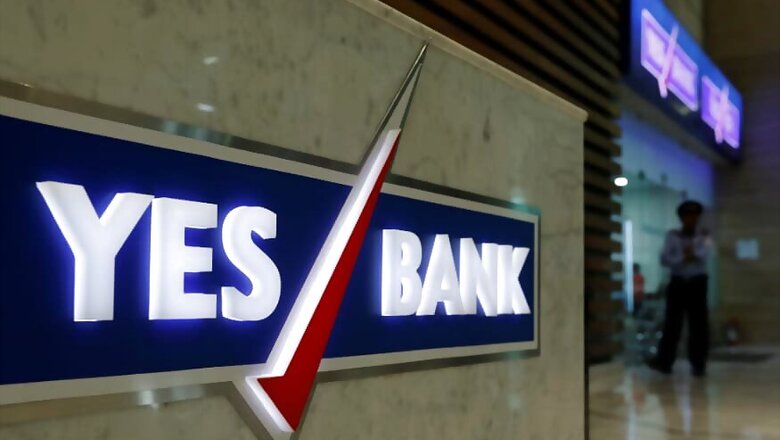
views
Having recognised a huge quantum of non-performing assets (NPAs) in the past few quarters, Yes Bank has created a dedicated stressed asset management vertical to recover and resolve such accounts that have touched Rs 50,000 crore, a top official said on Thursday.
The bank has also appointed six merchant bankers for a proposed capital raising exercise of up to Rs 15,000 crore in which it is aiming to get new investors, including global private equity funds, into the bank, its Managing Director and Chief Executive Officer Prashant Kumar told PTI.
Yes Bank's board had to be superseded by the Reserve Bank of India (RBI) and the government earlier this year after alleged mismanagement under its founder CEO Rana Kapoor.
It was bailed out by a string of lenders led by SBI, who pumped in Rs 10,000-crore fresh capital to keep it afloat. Kumar started off by recognising a huge pile of assets as bad, resulting in a massive Rs 18,000 crore loss for the December 2019 quarter.
"We have huge NPAs of nearly Rs 50,000 crore which is very large and needs a focused approach for recovery and resolutions," Kumar said adding that the bank is hoping to either recover or resolve up to Rs 8,000 crore in capital through the vertical in 2020-21.
Recovery and resolution of the stuck money can help future profits through writebacks of already made provisions against assets and also help the capital position of the bank, which stood at a very low 8.5 per cent as of March 31, 2020, Kumar said.
The vertical has 100 dedicated executives who are well versed with NPA management, he said adding that if required, the bank may also hire experienced hands for this activity.
The team will work "surgically" towards stressed asset resolution with their specialised skill sets and also unclog management bandwidth such that the leadership can focus on growing the bank.
At a later stage, the bank will look at segregation of assets or management to facilitate strategic spin off of these assets to a separate legal entity or sale to asset reconstruction companies, it said.
Meanwhile, on the capital raising plans, Kumar said the bank has a mandate to raise up to Rs 15,000 crore in fresh capital from various routes and had invited bids from merchant bankers.
After a scrutiny and presentations, it has appointed six rainmakers to help sell the issue, Kumar said, declining to give a timeline by when the capital will be raised.
"I will want the capital tomorrow," he quipped, and added that the raise will happen as soon as possible.
Kumar said that even in the gloomy times of COVID-19 pandemic, there are investors who are willing to take long-term bets, and added that the focus of the exercise is to tap newer investors beyond the ones that were involved in the bailout.
If not for the COVID-19 pandemic, the management would have guided towards a normalisation in NPA additions going ahead as well, Kumar said adding that the legacy stress in the book has been recognised.
There will not be heightened provisions in the time ahead, he said adding that at 74 per cent, the provision coverage ratio is at par with the industry.
The bank is targeting to grow the loan book by 10 per cent in 2020-21, which will involve a 20 per cent growth in retail segment and a de-growth in the corporate segment, Kumar said.
This will lead to the share of retail and small business loans to grow to a level of 60 per cent in the next two years from the current 44 per cent, he said.
On the liabilities front, a greater focus will be on getting retail deposits, Kumar said adding that while the trust has come back within them after the heavy withdrawals up to March, there is a competition from other saving instruments which may not result in a flow of money to banks.
The bank has reduced its term deposits rates by up to 0.25 percentage points across tenors in the last few days, and will also consider a reduction in its aggressive saving bank account deposit rate to reflect the market realities.
When asked if it will be as low as 2.75 per cent on the saving front, Kumar said that it will go for a higher level of up to 4 per cent interest, calling it "apt level" that does not put a strain on the depositor as well.
Initiatives of cost rationalisation, like relocating branches and ATMs to lower rental locations are also on, Kumar said adding that once things normalise on the revenue generation front, the cost-to-income ratio should come down to 40 per cent levels.
It is also targeting to take its net interest margin to 3 per cent from the 1.9 per cent in a quick time as more accounts start delivering interest payments, Kumar said adding that net interest margins at that level is a necessity for any lender.
Helped by a massive over Rs 6,200 crore gain arising out of a controversial write-off of bond investors' investment, it had reported a net profit of Rs 2,629 crore for the March quarter late on Wednesday.
The bank's shares on Thursday gained 6.83 per cent to close at Rs 28.15 apiece on the BSE.


















Comments
0 comment